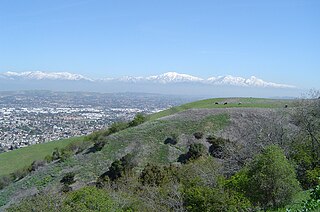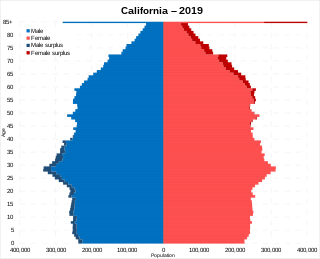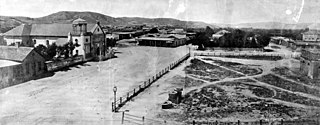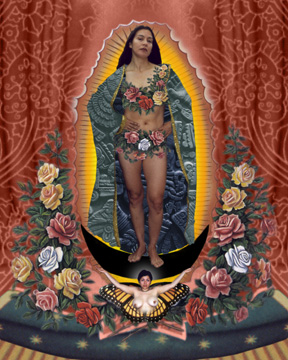
Chicano, Chicana, is an identity for Mexican Americans who have a non-Anglo self-image. Chicano was originally a classist and racist slur used toward low-income Mexicans that was reclaimed in the 1940s among youth who belonged to the Pachuco and Pachuca subculture. In the 1960s, Chicano was widely reclaimed in the building of a movement toward political empowerment, ethnic solidarity, and pride in being of indigenous descent. Chicano developed its own meaning separate from Mexican American identity. Youth in barrios rejected cultural assimilation into whiteness and embraced their own identity and worldview as a form of empowerment and resistance. The community forged an independent political and cultural movement, sometimes working alongside the Black power movement.

18th Street, also known as Calle 18, Barrio 18, Mara 18, or simply La 18 in Central America, is a multi-ethnic transnational criminal organization that started as a street gang in Los Angeles. It is one of the largest transnational criminal gangs in Los Angeles, with 65,000 members between the United States, Mexico, and Central America and is also allied with the Mexican Mafia, another US-based crime organization. A United States Department of Justice report featured the following statement regarding 18th Street and rival gang MS-13, "These two gangs have turned the Central American northern triangle into the area with the highest homicide rate in the world."

Sandra Cisneros is an American writer. She is best known for her first novel, The House on Mango Street (1983), and her subsequent short story collection, Woman Hollering Creek and Other Stories (1991). Her work experiments with literary forms that investigate emerging subject positions, which Cisneros herself attributes to growing up in a context of cultural hybridity and economic inequality that endowed her with unique stories to tell. She is the recipient of numerous awards, including a National Endowment for the Arts Fellowship, was awarded one of 25 new Ford Foundation Art of Change fellowships in 2017, and is regarded as a key figure in Chicano literature.

The San Gabriel Valley, often referred to by its initials as S.G.V., is one of the principal valleys of Southern California, lying immediately to the east of the eastern city limits of the city of Los Angeles and occupying the vast majority of the southeastern part of Los Angeles County, California. Surrounding features include:
Postcolonial feminism is a form of feminism that developed as a response to feminism focusing solely on the experiences of women in Western cultures and former colonies. Postcolonial feminism seeks to account for the way that racism and the long-lasting political, economic, and cultural effects of colonialism affect non-white, non-Western women in the postcolonial world. Postcolonial feminism originated in the 1980s as a critique of feminist theorists in developed countries pointing out the universalizing tendencies of mainstream feminist ideas and argues that women living in non-Western countries are misrepresented.

The Calcutta Chromosome is a 1995 English-language novel by Indian author Amitav Ghosh. The book, set in Calcutta and New York City at some unspecified time in the future, is a medical thriller that dramatizes the adventures of people who are brought together by a mysterious turn of events. The book is loosely based on the life and times of Sir Ronald Ross, the Nobel Prize–winning scientist who achieved a breakthrough in malaria research in 1898. The novel was the recipient of the Arthur C. Clarke Award in 1997.
Karen Tei Yamashita is a Japanese American writer.

California is the most populated U.S. state, with an estimated population of 39.2 million as of January 1, 2022. It has people from a wide variety of ethnic, racial, national, and religious backgrounds.
Mexican American literature is literature written by Mexican Americans in the United States. Although its origins can be traced back to the sixteenth century, the bulk of Mexican American literature dates from post-1848 and the United States annexation of large parts of Mexico in the wake of the Mexican–American War. Today, as a part of American literature in general, this genre includes a vibrant and diverse set of narratives, prompting critics to describe it as providing "a new awareness of the historical and cultural independence of both northern and southern American hemispheres". Chicano literature is an aspect of Mexican American literature.
Guatemalan Americans are Americans of full or partial Guatemalan descent. The Guatemalan American population at the 2010 Census was 1,044,209. Guatemalans are the sixth largest Hispanic group in the United States and the second largest Central American population after Salvadorans. Half of the Guatemalan population is situated in two parts of the country, the Northeast and Southern California.

Through the Arc of the Rain Forest is the first novel published by Japanese American author Karen Tei Yamashita. Primarily set in Brazil, the novel is often considered a work of magical realism but transgresses many literary genres as it incorporates satire and humor to address themes of globalization, transnationalism, migration, economic imperialism, environmental exploitation, socio-economic inequity, and techno-determinism. It follows a broad cast of characters across national borders, from Japan, Brazil, and the United States. The novel was written when Yamashita was in the United States after living nine years in Brazil.

Josh Kun is an American author, academic and music critic. Kun is Professor of Communication and Journalism and chair in Cross-Cultural Communication in the Annenberg School at the University of Southern California. He also holds a joint appointment at USC's Department of American Studies and Ethnicity. He is the director of USC Annenberg's School of Communication, director of The Popular Music Project at USC Annenberg's the Norman Lear Center and co-editor of the book series "Refiguring American Music" for Duke University Press.

The Mission Revival style was part of an architectural movement, beginning in the late 19th century, for the revival and reinterpretation of American colonial styles. Mission Revival drew inspiration from the late 18th and early 19th century Spanish missions in California. It is sometimes termed California Mission Revival, particularly when used elsewhere, such as in New Mexico and Texas which have their own unique regional architectural styles. In Australia, the style is known as Spanish Mission.
Asian Californians are residents of the state of California who are of Asian ancestry. California has the largest Asian American population in the U.S., and second highest proportion of Asian American residents, after Hawaii. As of the 2020 U.S. Census, there were over 6 million Asian-Americans in California; 15.5% of the state's population. If including those with partial Asian ancestry, this figure is around 17%. This is a jump from 13.8% recorded in 2010.

Mexican Americans have lived in Los Angeles since the original Pobladores, the 44 original settlers and 4 soldiers who founded the city in 1781. People of Mexican descent make up 31.9% of Los Angeles residents, and 32% of Los Angeles County residents.
Ato Quayson is a Ghanaian literary critic and Professor of English at Stanford University. He was formerly a Professor of English at New York University (NYU), and before that was University Professor of English and inaugural Director of the Centre for Diaspora Studies at the University of Toronto. His writings on African literature, postcolonial studies, disability studies, urban studies and in literary theory have been widely published. He is a Fellow of the Ghana Academy of Arts and Sciences (2006) and the Royal Society of Canada (2013), and in 2019 was elected Corresponding Fellow of the British Academy. He was Chief Examiner in English of the International Baccalaureate (2005–07), and has been a member of the Diaspora and Migrations Project Committee of the Arts and Humanities Research Council (AHRC) of the UK, and the European Research Council award grants panel on culture and cultural production (2011–2017). He is a former President of the African Studies Association.

Murakami is a Japanese surname, 35th by frequency in Japan. It can refer to:
The Asian American Literature Festival is a biannual Washington, D.C.–based literary festival dedicated to sharing and growing Asian American literature. It was first held in 2017.

The term Chicanafuturism was originated by scholar Catherine S. Ramírez which she introduced in Aztlán: A Journal of Chicano Studies in 2004. The term is a portmanteau of 'chicana' and 'futurism', inspired by the developing movement of Afrofuturism. The word 'chicana' refers to a woman or girl of Mexican origin or descent. However, 'Chicana' itself serves as a chosen identity for many female Mexican Americans in the United States, to express self-determination and solidarity in a shared cultural, ethnic, and communal identity while openly rejecting assimilation. Ramírez created the concept of Chicanafuturism as a response to white androcentrism that she felt permeated science-fiction and American society. Chicanafuturism can be understood as part of a larger genre of Latino futurisms.
Petrofiction or oil fiction, is a genre of fiction focused on the role of petroleum in society.












